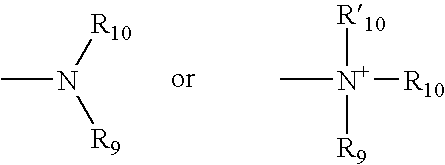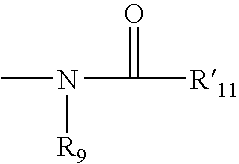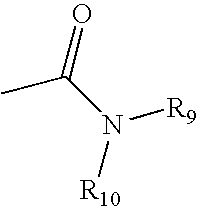Thiazole and other heterocyclic ligands for mammalian dopamine, muscarinic and serotonin receptors and transporters, and methods of use thereof
a technology of muscarinic and serotonin receptors and ligands, which is applied in the field of thiazole and other heterocyclic ligands for mammalian dopamine, muscarinic and serotonin receptors and transporters, and can solve the problems of limited number of compounds that can be synthesized, limited choice of reagents and conditions that can be used for the synthesis of non-oligomeric libraries, and desensitize receptor
- Summary
- Abstract
- Description
- Claims
- Application Information
AI Technical Summary
Problems solved by technology
Method used
Image
Examples
example 2
[0356] 18
[0357] A solution of 2-chloro-1-[1-(4-chlorophenyl)cyclobutyl]ethanone (120 mg, 0.494 mmol) and sodium iodide (74 mg, 0.494 mmol) in acetone (2.5 mL) was stirred at room temperature for 5 minutes. Next (3-diethylaminopropyl)thiourea (94 mg, 0.494 mmol) was added. The resulting mixture was heated at 50.degree. C. for 1 h. After the mixture was allowed to cool to room temperature, it was diluted with 5% sodium hydrogen carbonate in water and then extracted with ethyl acetate (2.times.50 mL). The extracts were combined, washed with brine (20 mL), dried over anhydrous sodium sulfate, filtered, and concentrated to give a colorless oil. The oil was purified by column chromatography on silica gel using dichloromethane / 2 N ammonia in ethanol (90:10) to give 162 mg of N'-{4-[1-(4-chlorophenyl)cyclobutyl]thiazol-2-yl}-N,N-diethylpropane-1-,3-diamine, 19, as a colorless oil. .sup.1H NMR (CDCl.sub.3, 300 MHz): .delta. 1.02 (t, 6H, J=7.2 Hz); 1.71-1.80 (m, 2H); 1.82-1.91 (m, 1H); 2.08-2...
example 3
[0358] A solution of N'-{4-[1-(4-chlorophenyl)cyclobutyl]thiazol-2-yl}-N,N--diethylpropane-1,3-diamine, 19, (78.9 mg, 0.209 mmol) and citric acid (40.2 mg, 0.209 mmol) in methanol (10 mL) was concentrated to give a colorless oil. The oil was dissolved in water (10 mL) and lyophilized to give N'-{4-[1-(4-chlorophenyl)cyclobutyl]thiazol-2-yl}-N,N-diethylpropane--1,3-diamine citrate salt, 20, as a white powder.
example 4
[0359] 19
[0360] Utilizing an analogous procedure to that outlined in Example 2, with thiourea (0.1 mmol), .alpha.-chloroketone (0.1 mmol), NaI (0.1 mmol), and acetone (0.5 mL), 32 mg of {4-[1-(4-chlorophenyl)-cyclobutyl]t-hiazol-2-yl}-(3-morpholin-4-yl-propyl)amine, 21, was obtained. .sup.1H NMR (CDCl.sub.3, 300 MHz): .delta. 1.73-1.91 (m, 3H); 2.01-2.17 (m, 1H); 2.43-2.59 (m, 8H); 2.66-2.75 (m, 2H); 3.25-3.31 (m, 2H); 3.72 (t, 4H, J=4.8 Hz); 5.90-5.93 (bs, 1H); 5.93 (s, 1H); 7.25 (s, 4H); .sup.13C NMR (CDCl.sub.3, 75 MHz): .delta. 16.9, 25.5, 34.2, 45.4, 49.1, 53.9, 57.3, 67.2, 100.4, 128.2 (2C), 131.5, 147.0, 159.8, 169.9.
PUM
| Property | Measurement | Unit |
|---|---|---|
| Stereoisomer | aaaaa | aaaaa |
Abstract
Description
Claims
Application Information
 Login to View More
Login to View More - R&D
- Intellectual Property
- Life Sciences
- Materials
- Tech Scout
- Unparalleled Data Quality
- Higher Quality Content
- 60% Fewer Hallucinations
Browse by: Latest US Patents, China's latest patents, Technical Efficacy Thesaurus, Application Domain, Technology Topic, Popular Technical Reports.
© 2025 PatSnap. All rights reserved.Legal|Privacy policy|Modern Slavery Act Transparency Statement|Sitemap|About US| Contact US: help@patsnap.com



